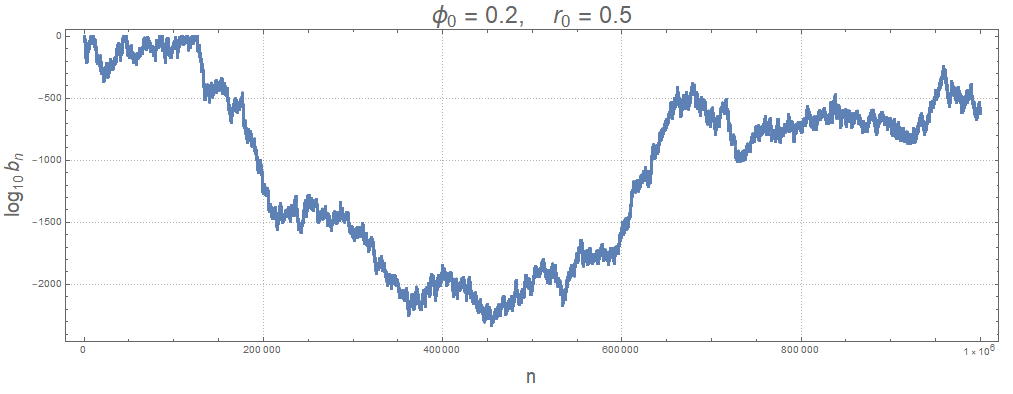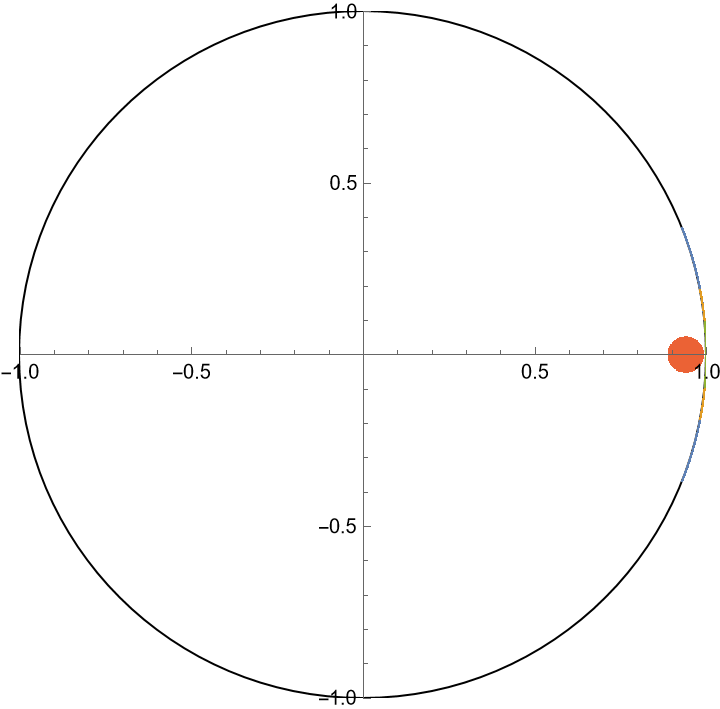OK, finally something about the measure. I'll put it into a separate answer again for readability. If the moderators frown upon such practice, they are welcome to merge in any way they find appropriate.
We shall show that for every Borel set $E\subset\mathbb D$, one has
$$
\mu(E\setminus \cup_{j\ge 1} T^{-j}E)=0\,.
$$
Here $Tz=z^2+1-|z|^2$ (I prefer to swap the coordinates, so that I can write $z=x+iy$) and
$d\mu(z)=\frac{dA(z)}{1-|z|^2}$ is the invariant measure.
By the general mumbo-jumbo, that means that almost every point of $E$ returns to $E$ infinitely many times, from which it trivially follows that for almost every $z\in\mathbb D$, we have $\limsup_{n\to\infty} [1-|T^nz|^2]\ge 1-|z|^2>0$, answering the original question in the affirmative. I strongly suspect that this upper limit is at least some constant almost everywhere and, maybe, even $1$, but I cannot prove that much yet.
So, suppose that $E\setminus \cup_{j\ge 1} T^{-j}E$ contains a set $G$ of positive measure that is contained in the disk $\{\rho(z)\le \Delta\}$ where $\rho(z)=\frac 1{1-|z|^2}$. Then the sets $T^{-j}G$ are pairwise disjoint and have the same $\mu$-measure $\mu(G)$ each.
Let $S_{\pm}$ be the two right inverses to $T$, so $S_+(z)=\left(\frac y{\sqrt{2(1-x)}},\sqrt{\frac{1-x}2}\right)$, $S_-(z)=-S_+(z)$. We have $\rho(S_{\pm}z)=2(1-x)\rho(z)$ and $\mu(S_{\pm}E)=\frac 12\mu(E)$.
The key lemma is the following. Consider the random process $z_0=z, z_{k}=S_{\pm}z_{k-1}$ whether $\pm$ are chosen independently with probability $\frac 12$ each. Then for every $\varepsilon>0$, there exists $N(\varepsilon)$ such that for all $n>N(\varepsilon)$, one has $$
P[\rho(z_n)>e^{\varepsilon n}\rho(z)]<\frac 12\,.
$$
If we know that, then we'll have $\mu(T^{-j}G\cap \{\rho<e^{\varepsilon n}\Delta\})\ge \frac{\mu(G)}2$ for $j=N(\varepsilon),\dots,n$, so we'll squeeze $n-N(\varepsilon)$ disjoint sets of measure $\frac{\mu(G)}2$ into the set $\{\rho<e^{\varepsilon n}\Delta\}$ of measure $\pi[\varepsilon n+\log\Delta]$. If $\varepsilon<\frac{\mu(G)}{2\pi}$, that is absurd for large $n$.
To prove the key lemma, fix two constants $\delta\ll c\ll\varepsilon$, a large integer $n$ and $m\approx cn$. We shall say that our random process is out of control at step $k$ if
$$
\rho(z_k)<4^{m}e^{ck}\rho(z)\,.
$$
Note that if the last out of control position $k$ is above $n-m$, then
$$
\rho(z_n)\le 4^{n-k}\rho(z_k)\le 4^{2m}e^{cn}\rho(z)\ll e^{\varepsilon n}\rho(z)\,.
$$
So, it suffices to estimate the probability of the event that the last out of control position is $k$ for all $k=0,\dots,n-m$ by something less than $\frac 1{2n}$. Note also that $z_0,\dots,z_m$ are all out of control ($\rho(z_k)$ grows at most $4$ times at each step).
Fix $k\in[m,n-m]$ now. Notice that the $k$ is an out of control position, but $k+1,\dots,k+m$ are not. That implies that $\rho(z_k)\le 4^{m}e^{ck}\rho(z)$ but $\rho(z_j)\ge 4^m$ for $j=k,\dots,k+m$. Thus, it will suffice to show that for each $w\in\mathbb D$ with $\rho(w)\le 4^{m}e^{ck}\rho(z)$, the conditional probability
$$
P[k+1,\dots,k+m\text{ are all in control}|z_k=w]\le \frac 1{2n}\,.
$$
Let $W=\frac{w}{|w|}$. Let also $W_j$ ($j=0,\dots,m$) be the square root random process starting with $W_0=W$ (at every step we choose one of the 2 square roots with probability $\frac 12$ each). The next claim is that every fully controlled path $z_k,\dots,z_{k+m}$ corresponds to its own unique path in the square root process so that $|z_{k+j}-W_j|\le 2\cdot 4^{-m}$, say. Clearly, $z_k=w$ is that close to $W_0=W$. Suppose that we have managed such coupling up to step $j$. Note that $z_k=Tz_{k+j+1}=z_{k+j+1}^2+(1-|z_{k+j+1}|^2)$ differs from $z_{k+j+1}^2$ by at most $4^{-m}$ and, thereby, $|z_{k+j+1}^2-W_j|\le 3\cdot 4^{-m}$. Now we need an elementary lemma in the unit disk. If $|a|=1,|b|<1$ and $|a^2-b^2|<\gamma<\frac 14$, then $|a-b||a+b|<\gamma$, whence $|a-b|<\sqrt{\gamma}<\frac 12$ or $|a+b|<\sqrt{\gamma}<\frac 12$. In the first case $|a+b|\ge\frac 32$, so $|a-b|\le \frac 23\gamma$. In the second case $|a+b|\le \frac 23\gamma$. Applying it to our situation, we see that $z_{k+j+1}$ is $2\cdot 4^{-m}$ close to one of the two square roots of $W_j$ and if we can make both choices $z_{k+j+1}=S_{\pm}z_{k+j}$, they are close to opposite roots of $W_j$ being the opposite numbers themselves. Thus we can couple up to $j+1$ as well.
Now, let $X(\zeta)$ be the $x$-coordinate of $\zeta$. Consider the path $W_j$ coupled with a controlled path $z_{k+j}$ ($j=0,\dots,m$). Let us define the regularized logarithm $L_\delta(t)$ as $\max(\log(|t|,\log\delta)$. Note that $L_\delta(t)$ dominates $\log|t|$ for all $\delta>0$ and $L_\delta$ is $\delta^{-1}$-Lipschitz. We now have the chain of inequalities
$$
\log\rho(z_{k+m})=\log\rho(z_k)+\sum_{j=0}^{m-1}\log(2(1-X(z_{k+j})))
\\
\le \log\rho(z_k)+\sum_{j=0}^{m-1}L_\delta(2(1-X(z_{k+j})))\le
\log\rho(z_k)+4m\delta^{-1}\cdot 4^{-m} +\sum_{j=0}^{m-1}L_\delta(2(1-X(W_j)))\,.
$$
On the other hand, to keep $z_{k+m}$ in control, we must have $\log\rho(z_{k+m}\ge cm+\log\rho(z_k)$. Thus, the conditional probability we are interested in is at most
$$
P\left[\sum_{j=0}^{m-1}L_\delta(2(1-X(W_j))\ge cm-4m\delta^{-1}\cdot 4^{-m}\ge cm-\delta^{-1}\right]\,.
$$
On the other hand, we know the exact distribution of $W_m$: it is a uniform measure on the roots of order $2^m$ of $W$, i.e., a geometric progression with the step $e^{2\pi i\cdot 2^{-m}}$ on the circle that has one point on each arc of length $2\pi\cdot 2^{-m}$. Note now that if $|\zeta|=|\xi|=1$ and $|\zeta-\xi|<2\pi\cdot 2^{-m}$, then
$|L_\delta(2(1-X(\zeta^{2^j})))-L_\delta(2(1-X(\xi^{2^j})|\le 2^{j-m} 2\pi\delta^{-1}$.
Thus, if the sum $\sum_{j=1}^m L_\delta(2(1-X(\zeta^{2^j})))$ is above $cm-\delta^{-1}$ anywhere on the arc, it is above $cm-15\delta_{-1}$ on the whole arc. Thus, it suffices to estimate the probability that
$$
\sum_{j=1}^m L_\delta(2(1-X(\zeta^{2^j}))\ge cm-15\delta^{-1}
$$
where $\zeta$ is uniformly distributed on the unit circumference.
We will use some elementary Fourier analysis for that. Write
$$
L_\delta(2(1-X(\zeta)))=\sum_{q\in \mathbb Z} a_q\zeta^q\,.
$$
We then have $|a_0|\le \alpha(\delta)$ where $\alpha(\delta)\to 0$ as $\delta\to 0$ and
$\sum_{q\ne 0}|a_q|\le \beta(\delta)<+\infty$ (explicit bounds are not hard, but I don't need them). Let $F(\zeta)=\sum_{j=1}^m\zeta^{2^j}$. Then the sum we are interested in can be written as
$$
\alpha(\delta)m+\sum_{q\ne 0}a_qF(\zeta^q)\,.
$$
The first term can be made less than $\frac c2 m$ if $\delta>0$ is chosen small enough after $c>0$. So we are left with estimating the probability that
$$
\sum_{q\ne 0}a_qF(\zeta^q)>\frac c2 m-15\delta^{-1}\,.
$$
By the standard facts about lacunary series (if you've read Zygmund's book, you know much more than I'll use already; if not, you are welcome to request a proof and I'll come up with something reasonably short), we have $\|F\|_{L^4}\le K\sqrt m$. Hence the $L^4$ norm of our sum is at most $K\beta(\delta)\sqrt m$. Thus, the probability in question is bounded by
$$
\frac{K^4\beta(\delta)^2m^2}{(\frac c2m-15\delta^{-1})^4}\le \frac{A(c,\delta)}{n^2}
$$
when $n\ge N(c,\delta)$ (recall that $m\approx cn$), which is better than we need if $n$ is also greater than $2A(c,\delta)$, say.
I tried to keep it as simple as I could sacrificing precision for clarity everywhere, but it still looks a bit involuted. So remember that you can ask any number of questions if something is unclear.













